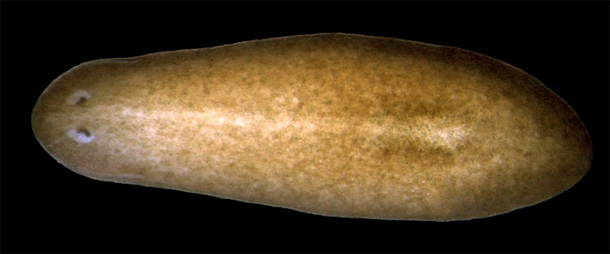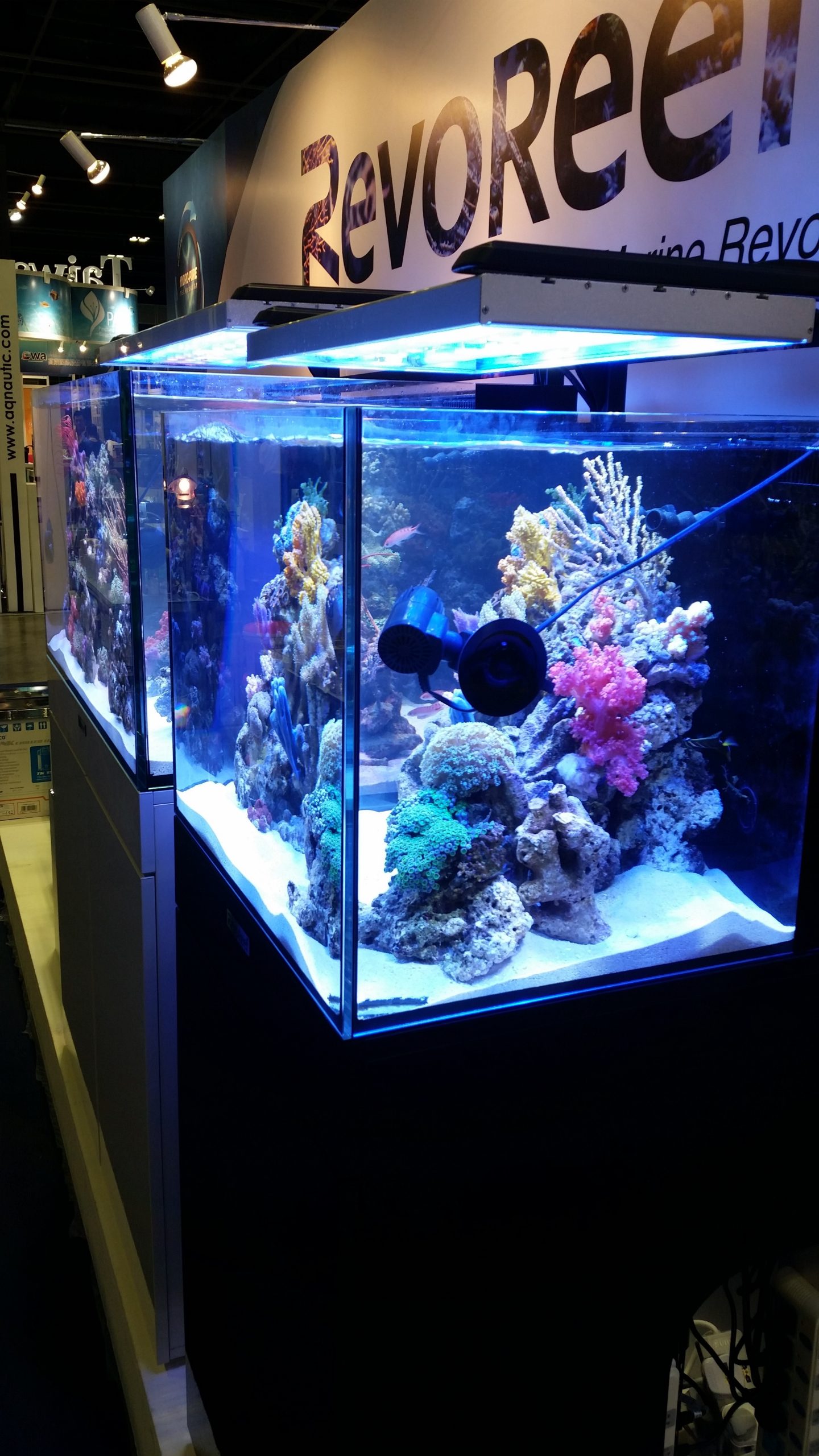A guide to Dragonets mandarin fish (Synchiropus)
Dragonets
Often, aquarists will come across threads on forums talking about the difficulty of keeping mandarins. Yet despite the inherent difficulty in keeping them, it is hardly surprising that many aquarists have been enticed into doing so. Especially where green mandarins are concerned, their vivid colouration is unlike any other fish. Given the interest which frequently surrounds, this article attempts to shed some light on this interesting group of fishes.

I. Types of dragonets
Usually when mandarins are mentioned, there’s a tendency to associate the term with green mandarins. However, as will be shown, green mandarins are only one species in this diverse family.
A. Dragonets commonly encountered
At least in Singapore, there are a number of dragonets that arrive at our shores quite regularly. These include the green mandarins, spotted mandarins, scooter blennies, red scooter blennies, red ruby dragonets, fingered dragonets and kuiter’s dragonets.

(1) Green mandarin
Scientific name: Synchiropus splendidus
Common names: Green mandarin
Distribution: Western pacific (Ryukyu Islands to Australia)[1]
Difficulty: Difficult
Temperament: Peaceful except with members of the same species of the same gender
Compatibility: Reef safe
As with all dragonets, these fish are incredibly hardy. With their thick slime coat, they are highly resistant to marine ich. However, it bears noting that they are still susceptible to marine velvet.
However, the real difficulty with these fish is their picky eating habits. Gut analysis of green mandarins in the wild have shown that their diet consists of “harpacticoid copepods, polychaete worms, small gastropods, gammaridean amphipods, ostracods and fish eggs.”[2] To the average aquarist, it is difficult to keep up with the nutritional needs of these fish. It is usually suggested that these fish should only be kept in a mature aquarium with a healthy population of “pods”. Nonetheless, this is an approximation at best and there is no guarantee that that these fish will not decimate the population of microfauna. Fortunately, it is possible to wean these fish onto prepared foods, albeit with great difficulty. Foods usually used here include newly hatched brine shrimps, adult brine shrimps, frozen mysis shrimps, nutrimar ova and to a greatly limited extent, regular sinking marine pellets. In this author’s opinion, because these fish are so picky, it is best to get the fattest specimen possible. Emaciated specimens may well be beyond hope.
Moving on, for the budding breeding or the enthusiastic aquarist, it is good to note that these fish are sexually diamorphic. The elongated dorsal fin of male S. splendidus easily sets it apart from the female. Additionally, male S. splendidus are also larger than their female counterparts.
As with other dragonets, S. splendidus is a pelagic spawner. At dusk, the pair may perform a courtship ritual before the female mandarin rests on the male mandarin’s pelvic fin and begins an ascent. The pair would then simultaneously release egg and sperm before darting back into the rocks for safety.
Less commonly, aquarists may encounter a variant of S. splendidus. The definitive test here is to look out for the pelvic and pectoral fins. The red variant has red fins instead of the usual blue fins. This variant is from the Philippines.

(2) Spotted mandarin
Scientific name: Synchiropus picturatus
Common names: Spotted mandarin, Picturesque dragonet, Target mandarin, Psychedelic mandarin
Distribution: Western pacific
Difficulty: Difficult
Temperament: Peaceful except with members of the same species of the same gender
Compatibility: Reef safe
The general care of S. picturatus is very similar to S. splendidus. However, this author has a few observations to make here. First, S. picturatus tends to be more aggressive towards conspecifics as compared to S. splendidus. Often where both species are in the same aquarium, the former will display one-sided aggression towards the latter. Second, S. picturatus is a smaller fish than S. splendidus. Third, S. picturatus seems to be easier to wean onto prepared foods as compared to S. splendidus.
When sexing S. picturatus, as with S. splendidus, the point of comparison lies with the length of the dorsal fin. Although less pronounced than male S. splendidus, male S. picturatus still possess noticeably longer dorsal fins than their female counterparts.
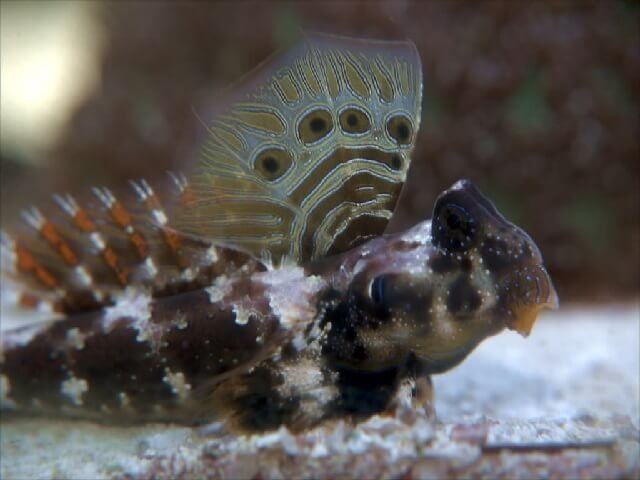
(3) Scooter blenny
Scientific name: Synchiropus ocellatus
Common names: Scooter blenny, Ocellated dragonet
Distribution: Western pacific (Ryukyu Islands to Australia)[3]
Difficulty: Difficult
Temperament: Peaceful except with members of the same species of the same gender
Compatibility: Reef safe
Although the colours of S. ocellatus are drab, it is during courtship displays that the stunning dorsal fin of the male S. ocellatus holds its own candle to other dragonets. As with other dragonets, the sexing of this species can be done by observing the dorsal fins.
Perhaps because this fish is much easier to wean onto prepared foods as compared to any other dragonet in the author’s experience, it is worth considering as a potential candidate for initial forays into dragonets. However, this is by no means easy when compared to most other fish.
Additionally, it is worth mentioning that S. ocellatus is especially prone to carpet surfing. If an aquarist does not wish to wake up to dried S. ocellatus, it may be wise to keep them in euro-braced tanks or keep them in tanks with lids.
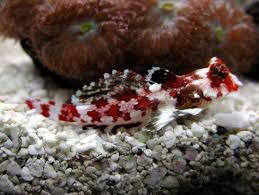
(4) Red scooter blenny
Scientific name: Synchiropus stellatus
Common names: Red scooter blenny, Red scooter dragonet, Starry dragonet
Distribution: Indian Ocean (East Africa to Sumatra). Also around oceanic islands[4]
Difficulty: Difficult
Temperament: Peaceful except with members of the same species of the same gender
Compatibility: Reef safe
The red scooter blenny is in most regards, similar to S. ocellatus. Some signs of aggression may be present between S. stellatus and S. ocellatus. As with S. ocellatus, the males have spectacular dorsal fins.

(5) Red ruby dragonet (Synchiropus sycorax)
Scientific name: Debatable[5]
Common names: Red scooter blenny, Red scooter dragonet, Starry dragonet
Distribution: These fish are usually shipped in from Philippines
Difficulty: Difficult
Temperament: Peaceful except with members of the same species of the same gender
Compatibility: Reef safe
Red ruby dragonets can be easily differentiated from S. stellatus by observing the pectoral fins. Pectoral fins of the former species are yellow.
With respect to the ease of care of these fish, the increased difficulty with red ruby dragonets can be attributed to the size of their mouths. These fish are generally smaller than the aforementioned dragonets. Correspondingly, the small size of their mouths makes it harder to wean them onto most pellets.
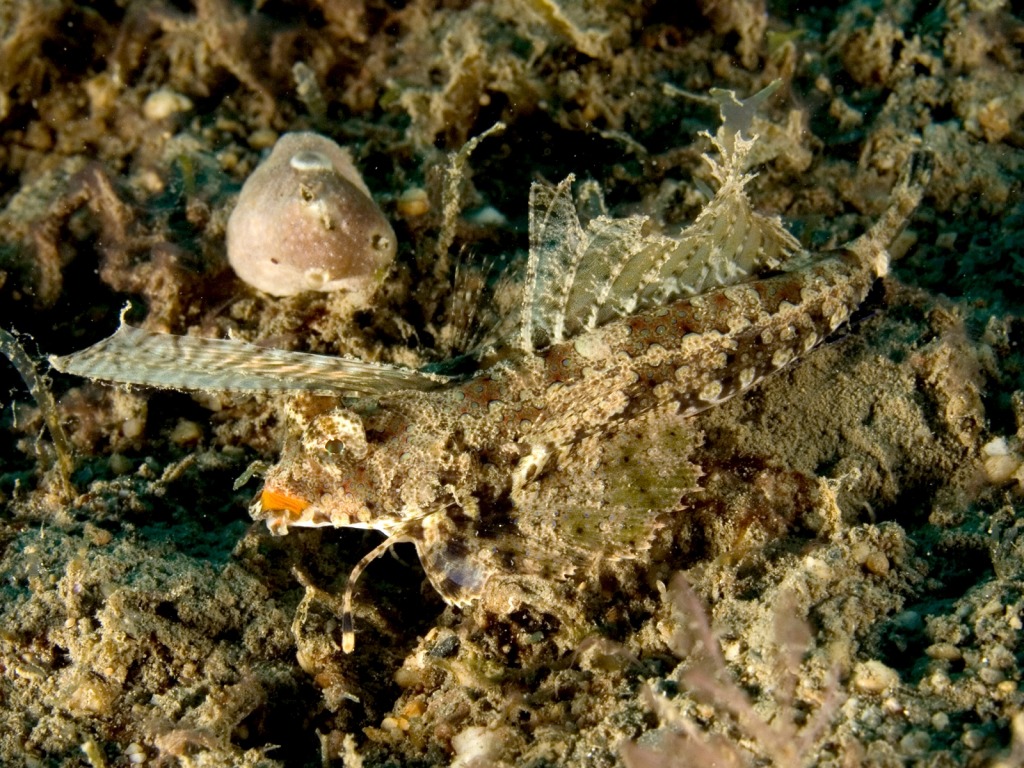
(6) Fingered dragonet
Scientific name: Dactylopus dactylopus
Common names: Fingered dragonet
Distribution: Western Pacific (Japan to Australia. Including Guam and Palau)[6]
Difficulty: Difficult
Temperament: Peaceful except with members of the same species of the same gender
Compatibility: Reef safe
Uniquely, the fingered dragonet is so named because of the presence of an extension of its ventral fins that makes the fish look like it has fingers. Due to its peculiarity, it makes for an interesting specimen in aquariums. However, as with other dragonets, this fish is picky where food is concerned.
Apart from dietary needs, there are two factors additional factors that an aquarist should take note of before purchasing these fish. First, D. dactylopus is usually much larger than S. splendidus. This would rule out the possibility of keeping these fish in smaller tanks. Second, in this author’s experience, this fish prefers open sand beds. Unlike the dragonets mentioned above, this fish does not scoot along the sides of rockwork. Instead, it spends its time moving along the bottom. Adequate space for it to do so should be provided for. On a similar note because this fish buries itself in sand when it rests, an aquarium with a sandy bottom would probably be preferable.
To differentiate between genders, males have filamentous extentions on their first dorsal fin.[7]

(7) Kuiter’s dragonet
Scientific name: Dactylopus kuiteri
Common names: Kuiter’s dragonet, Orange black dragonet
Distribution: Western Central Pacific (Indonesia)[8]
Difficulty: Difficult
Temperament: Peaceful except with members of the same species of the same gender
Compatibility: Reef safe
D. dactylopus and D. kuiteri are often confused for one another. In fact, whenever shipments arrive at our shores, the two species are not distinguished. However, it is easy to tell the difference between these two species by looking at the dorsal fins. D. dactylopus has a dorsal fin that does not swing forward as much as that of D. kuiteri. Further, D. dactylopus’s dorsal fin has clearly pronounced filaments. The upper jaw of D. kuiteri is also orange in colour.
Interestingly, this fish is also native to the waters of Singapore.
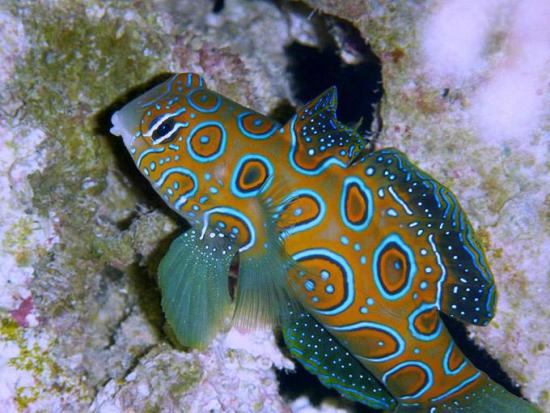
(8) West Australian dragonet
Scientific name: Synchiropus occientalis
Common names: West Australian dragonet
Distribution: Western Central Pacific (Indonesia)[9]
Difficulty: Difficult
Temperament: Likely peaceful except with members of the same species of the same gender
Compatibility: Reef safe
On a cursory glance, S. occientalis would very much resemble S. picturatus. However, where appearance is concerned, there are a number of notable differences. First, the former bears distinct white stripes across the eyes. Second, the colouration of the body of S. occientalis is almost orange. Third, the circular pattern around S. occientalis is better described as rings as opposed to S. picturatus, which may appear to be more akin to coloured in circles. Fourth, S. occientalis has multiple fine blue spots all over its body.
In any case, this dragonet is not easily available at most LFS.

(9) Circled dragonet[10]
Scientific name: Synchiropus circularis
Common names: Circled dragonet
Distribution: Western Pacific[11]
Difficulty: Likely to be difficult
Temperament: Unknown
Compatibility: Likely
From the very limited photos available of this fish, this species has looks between that of a scooter blenny and a perhaps S. picturatus. Here, a few characteristics may be compared:
Dorsal fin of S. circularis resembles that of the scooter blennies.
Interestingly though, there have been reports of spawning attempts occurring naturally between S. circularis and S. splendidus. However, successful hybrids have not been documented.
Once again, this species is not readily available at most LFS.
[1] Fishbase website <http://www.fishbase.org/summary/12644> (accessed 22 December 2015).
[2] Yvonne Sadovy, George Mitcheson & Maria B Rasotto, Early development of the mandarinfish, Synchiropus splendidus, (Callionymidae), with notes on its fishery and potential for culture” in Aquarium Sciences and Conservation, 2001, Volume 3, Number 4 Page 253 at p 261.
[3] Fishbase website <http://www.fishbase.org/summary/12644> (accessed 22 December 2015).
[4] Fishbase website <http://fishbase.org/summary/7802> (accessed 22 December 2015).
[5] Jake Adams, “Ruby red dragonet make simultaneous worldwide splash” Reefbuilders (19 April 2013) <http://reefbuilders.com/2013/04/19/rubyb-red-dragonet-simultaneous-worldwide-splash/> (accessed 22 December 2015).
[6] Fishbase website <http://fishbase.org/summary/8240> (accessed 22 December 2015).
[7] Joachim Frische, “The Fingered Dragonet, Imposing presence – inconspicuous colouration” Aqualog News <http://www.aqualog.de/Aqualog/news/web90/Seite23-24e.pdf> (accessed 22 December 2015).
[8] Fishbase website <http://www.fishbase.org/summary/60086> (accessed 22 December 2015).
[9] Fishbase website <http://www.fishbase.org/summary/60086> (accessed 22 December 2015).
[10] Jake Adams, “Synchiropus occientalis dragonet from West Australia seen on video for the first time” Reefbuilders (19 June 2012) <http://reefbuilders.com/2012/06/19/synchiropus-occidentalis-dragonet-west-australia-video-time/> (accessed 22 December 2015).
[11] Fishbase website < http://www.fishbase.org/summary/17472> (accessed 02 January 2015).


